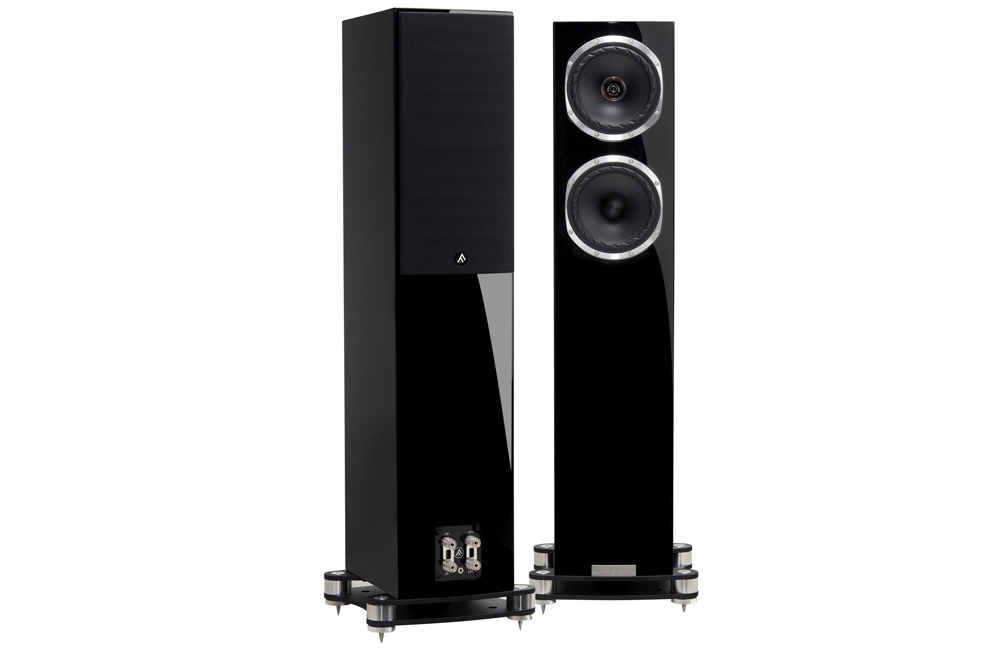As far as audio is concerned, one of my greatest regrets is naively selling a pair of beautifully-refurbished Tannoy Cheviot Dual-Concentric speakers. Back in the mid-‘90s, an inherited set of mint DC 12-inch raw drivers and crossovers had me embarking on an enclosure-building exercise. After much research and the generous assistance from then-importer Syntec, I commissioned South Australian craftsmen to build a cabinet to Tannoy specifications employing heavier-gauge MDF, an improved bracing scheme and a first-class Australian Jarrah wood veneer. It was a thing of beauty. The Cheviots played with a semi-vintage sound that straddled the musicality of yesteryear with the precision of more contemporary designs. Naturally, Tannoy has continued to evolve its product catalogue, however, a few years ago, a portion of its key personnel left the company, subsequently starting Fyne Audio. On an alternate path from its inception, the budding company has nurtured fresh ideologies and developed technologies of its own while respectfully drawing from former engineering achievements. How will the new mid-level Fyne Audio F501SP fare within the prestigious canon of coupled-driver masterpieces?
All is Fyne
The Fyne Audio F501SP may be the mid-position model within the company’s mid-level line but nothing about it would point to its relative affordability. On the contrary, this is a first-class, luxurious loudspeaker handcrafted in the UK, bearing little in the way of compromise in terms of construction, fit-and-finish and overall quality. In Fyne-speak, the ‘SP’ in its denomination means this is a ‘Special’ premium version of the award-winning F501. So visually, the SP’ed speaker is endowed with a truly stunning multi-stage gloss finish applied over the beautiful dark walnut-veneered, subtly-curved cabinet. However, this is not just an exercise in superficially making the F501 prettier – there are a number of engineering enhancements which truly place the F501SP over-and-above its simpler-model inspiration.
So, Fyne Audio engineers (led by Technical Director Dr Paul Mills) employed several trickle down technologies on the 2.5-way F501SP which are directly derived from the up-tier 700 series (which in turn takes many from the flagship F1 line). The F501SP incorporates an upgraded main ‘point source’ transducer now referred to as the SP Isoflare driver. A re-working of concentric designs, the 150mm (6 inch) SP Isoflare incorporates the 700 series-derived 25mm magnesium dome diaphragm compression tweeter and multi-fibre diaphragm cone midrange driver. The driver cone is suspended via a ‘FyneFlute’ roll surround which features slots – or flutes – aimed at reducing extraneous cone energy and acoustic reflections for a more linear performance and a claimed less coloured sound.
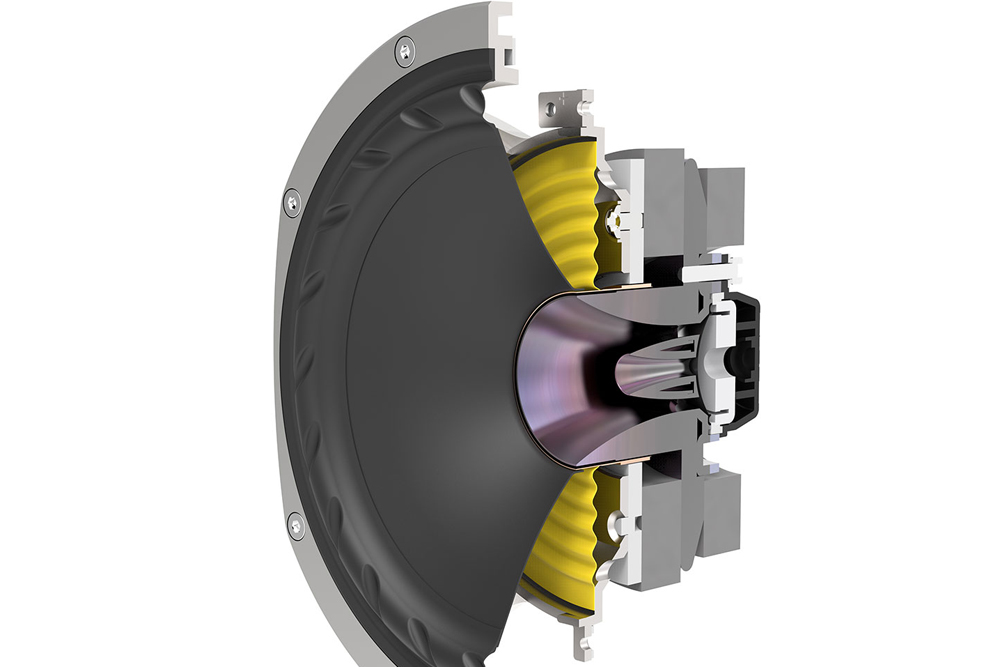
This is a superbly engineered driver supported via a cast aluminium chassis and bearing a massive ‘flux-focusing’ magnet system. Within the motor, Fyne Audio engineers have placed a pole piece incorporating an efficient heatsink allowing high power output. Further heat dissipation is provided by a strategically-vented rear chamber. The SP Isoflare driver’s voice coil is effectively massive, as it’s built as an externally-encompassed element over the tweeter’s construction. Said tweeter projects via a reworked flare which has been optimised via “extensive computer modelling” in order to provide flat frequency response, target dispersion and high frequency extension to the design parameter of 30 kHz. The driver has been designed to push low frequency resonance below the crossover point while break-up modes appear way above human hearing capacity.
An additional 150mm driver provides further low-end support to the point source driver and itself features a powerful magnet motor and the same FyneFlute surround design. The F501SP’s low frequencies are supported via Fyne Audio’s ‘BassTrax Tractrix’ diffuser bass augmentation system, a resizing of the scheme adopted on the F700 series. A dual cavity enclosure arrangement provides support to a tuned long-funnel port which vents/exits via the speaker’s bottom panel, expelling onto a Tractrix-shaped diffusing cone. The resulting port output projects into the room in a 360 degree wave with the potential to more evenly integrate its energy as it couples with the room’s acoustics. This translates to a speaker system which, in theory, is less position-fussy. I wouldn’t say the F501SP is a plonk-and-go exercise in loudspeaker room positioning – a design of this quality deserves careful setup. However, F501SP placement should be a far easier task than that of your garden variety rear- or front-ported design, as my experience verified.
Given the custom driver architecture and bass-loading scheme, I communicated with Technical Director Dr Paul Mills to provide further insights into what makes a Fyne Audio speaker and, more specifically, the F501SP.
I first asked about the most significant differences between the proprietary point source IsoFlare driver and the famed dual-concentric designs by Fyne Audio’s most obvious competitor.
The most obvious difference (by design) is the HF waveguide, which has been computer optimised to give a more accurately defined expansion rate. This minimises reflections and discontinuities for a flatter frequency response, lower distortion and more even dispersion. The magnesium tweeter dome used on SP, a trickle down from the F700 series, has better internal damping than the more commonly used aluminium or titanium domes. Although more expensive and more difficult to form, the resulting lack of stored energy increases accuracy and transparency.
Also evident is the FyneFlute surround on the bass/mid driver. Whereas a conventional surround can give rise to mis-termination of energy and reflections back along the cone at certain frequencies, the non-homogenous profile created minimises this effect.
I followed by asking what were the challenges in matching, or padding down, IsoFlare's compression tweeter's high efficiency to the more modest efficiency of the mid-bass driver and the related cohesion issues, while also dealing with the tonality of the differing diaphragm materials.
The IsoFlare is designed to give an increasing output at lower frequencies, which is made flat by a simple 1st order crossover (single capacitor). This gives improved power handling and reduced distortion, while allowing a pretty low crossover frequency of 1.7kHz, in the case of the F501SP. This frequency is below that where the bass/mid cone goes into break up modes and we find that when used as such, the paper pulp cone is very neutral sounding. So both the bass/mid cone and tweeter dome are acting pretty well as perfect pistons at the crossover point, for a natural sounding transition. The high frequency range of the tweeter is level matched with a resistor, having a low ohmic value, similar to that of a conventional discrete system.
Through my auditioning period I consistently found the F501SP's low-end very smooth and quite powerful at all room positions which, of course, points to the BassTrax Tractrix system performing as claimed. Was BassTrax the end result of development in that methodology specifically or did it come about as a result of research into an alternate bass enhancement system to reflex loading?
We looked at the disadvantages often associated with reflex loading, used to augment low frequency response. The bass port often exits to the front or rear of the enclosure. Front loading can result in audible distortion from turbulence in the port, while rear loading can result in impaired performance from the proximity of a rear wall. A third option is downwards firing , which is seen on a small number of current designs, and gives a more predictable interface between the port and the room, making the loudspeaker less sensitive to room positioning.
With this downwards firing system, a base plate is positioned at a set distance from the bottom of the enclosure, to allow for 360 degree venting and controlled energy interface to the room. The problem of reflections from this base plate we solved by a contoured acoustic diffuser, which aims to translate the plane wave exiting the enclosure to a spherical wavefront into the room, without unwanted reflections. The Tractrix profile we applied to this diffuser ensures that the plane wave from the port always exits at 90 degrees with no reflections. Our Patent on this technique has recently been granted.
Fyne Audio specifies the F501SP as having an in-room frequency response spanning from 36 Hz to 34 kHz (-6dB). A sensitivity of 91dB (2.83V at 1m) and a nominal impedance of 8 ohms points to a reasonably easy drive for even low-powered valve amplifiers, with solid state designs sure to comfortably just cruise along.
In order to wring the best performance from the F501SP’s driver array, Dr Mills also improved the crossover design with higher-grade components (crossover point at 250 Hz and 1.7 kHz, 2nd-order low-pass and 1st-order high-pass) employing low-loss laminated core inductors and high grade polypropylene capacitors. For the crossover-to-driver interface, Fyne Audio selected OFC cable from renowned specialist Van den Hul. Twin good quality binding posts allow for bi-wiring.
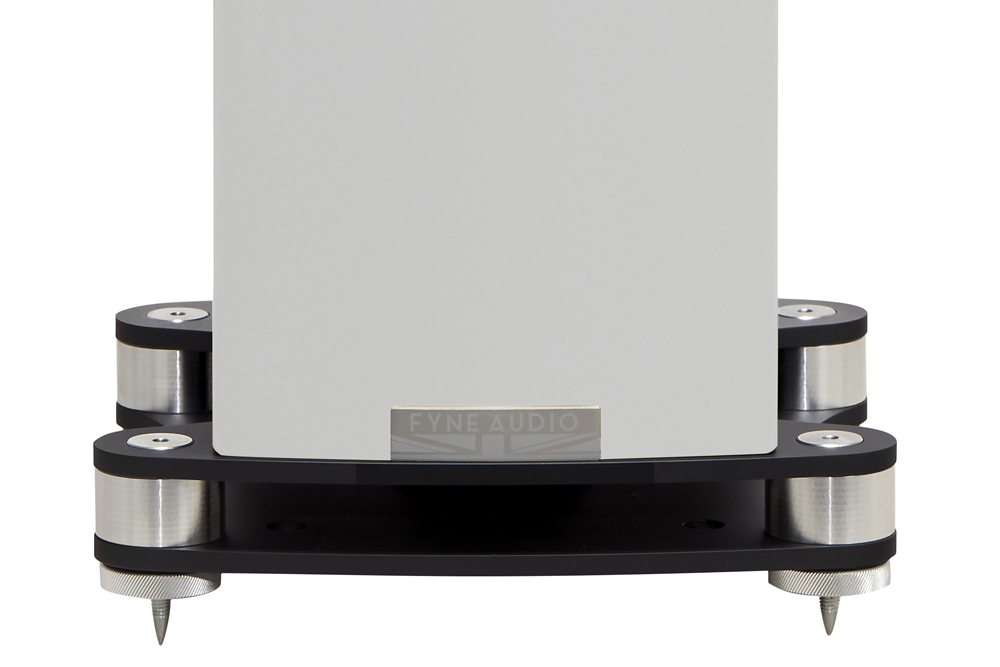
The speakers stand on a custom dual-platform aluminium plinth, with the independent plates separated via machined solid aluminium spacers. The top section, actually made-up of two solid bars, allows for the port exit while the lower solid plate provides the platform for the BassTrax Tractrix wave dispersion cone. Machined aluminium discs, or “knurled lock nuts” as referred to by Fyne Audio, pair as an interface between the plinth and floor spikes allowing easy levelling and solid coupling to hard floors. Aluminium floor protectors are provided. A classy little Allen key tool is also provided in order to allow easy spike adjustment/levelling from above without moving the speakers.
The F501SP’s small floor-standing size is subtly enhanced by its gently-curving front and rear panels. It’s a very pretty-looking speaker which, in addition to its glorious gloss finish over the walnut veneer, is further enriched by the polished aluminium driver chassis. The chassis visually couple with the aluminium ‘Fyne Audio’ front panel branding plate and the theme continues in the hardware around the plinth. Fit and finish is first rate. Overall, it’s a pleasing aesthetic which, with the gloss black and white options in addition to our review sample’s glorious walnut gloss, will fit into any modern or traditional setting.
Making Trax
I should start-off by stating that the F501SPs provided some of the best bass I’ve experienced in the last two years since moving to the new digs. Granted, the acoustic treatment and bass traps, in conjunction with a fairly open-boundary room build and solid concrete floor, have provided excellent low-end performance from just about every loudspeaker I’ve had in-house. That, is both a testament to the success of the room tune and the engineering prowess of modern loudspeaker designs.
Yet, Fyne Audio is onto something with this BassTrax Tractrix thing. Not only was the low-end beautifully integrated with the rest of the spectrum, it was tight, super-punchy and, subjectively, dipped lower than the size of the box – and the specs – would indicate. Plus, I was able to get consistently excellent results in several positions around the room, providing further proof of concept. Nonetheless, after some experimentation, I repositioned the F501SPs in an approximate location where so many speakers have also provided best performance across the mid-band and top-end.
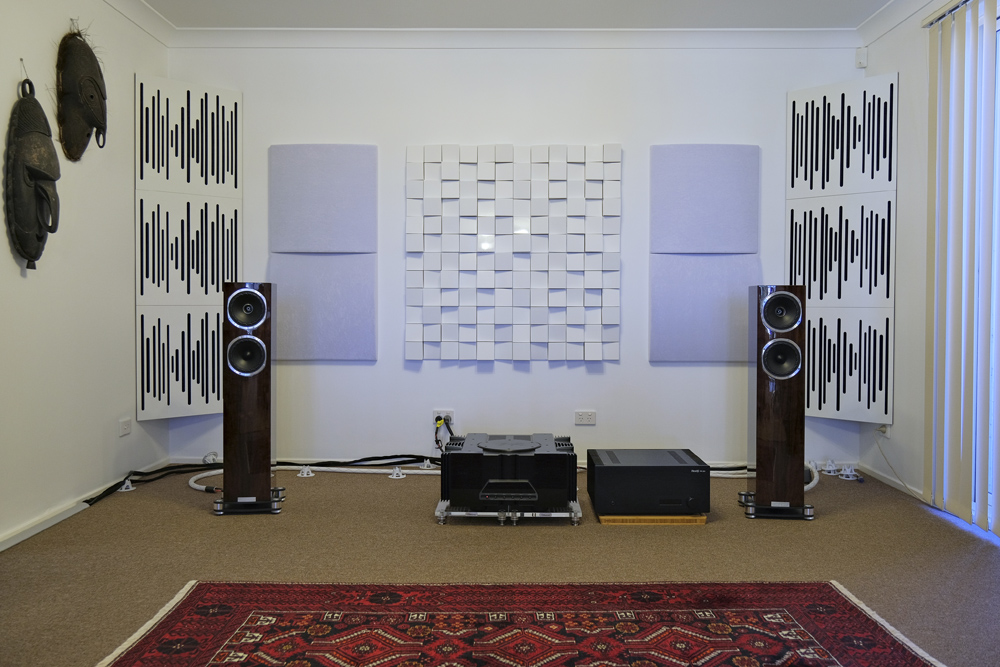
So while on the subject of excellent bass performance, I relished the forceful tautness of the kick drum on Ben Harper’s “Whipping Boy” from his Welcome to the Cruel World album. The intro’s slide guitar was an insightful demonstration of the F501SPs’ excellent detail retrieval and accurate tonality too while, as the intro wanes to the song proper, also reproducing the dynamism of the drums which kick the track along. This is great dynamic expression from what is, effectively, a compact floorstander. Pint-sized power here.
There were ample pleasures to be had on “U Can’t Hold No Groove” and “Justice” from Victor Wooten’s A Show of Hands 15 album on Tidal where the F501SPs roared and smacked with potent lows. There were ample pyrotechnics, both from Wooten and the F501SPs, when it came to the electric bass notes’ attack and clear transients, but there was also superbly-rendered subtle nuance, detail and precise tonal content.
As good as the F501SPs were with any low-end content, they are not a one trick pony. The mid-band showed terrific dynamism, with its slight forwardness making for realistically-present vocals. The sound is pushed at the listening seat not in a rough-and-ready way but rather in a propulsive way which provides excellent ‘PRaT’… it’s a rhythm machine with excellent pulsating beat power. Feed them the dense guitar atmospherics of any track on My Sleeping Kharma’s Satya album and you’ll be swept away in an ethereal trance enhanced by the throbbing drum runs.
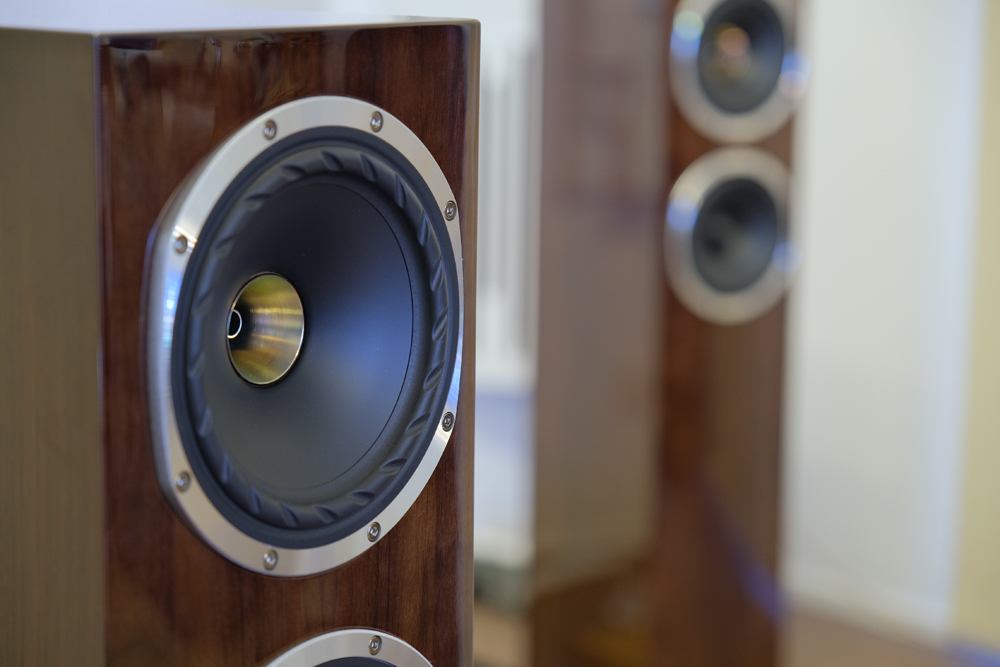
Denser rock music maintains the rhythmic flow and powerful bass tempos, however, frantic guitar riffs, like the post-intro explosion of “Rational Woman” from Sasquatch’s Manoeuvres sounded a tad congested when compared to some of the speakers in-house over the last few months, albeit, all of which were much more expensive designs.
Orchestral works fared superbly. I enjoyed the instrumental arrangements of Peter Gabriel’s “My Body is a Cage” from Scratch My Back. The F501SPs mindfully maintain the sense of foreboding the track emanates through the palpitations of the piano’s lower keys and the resolution of Gabriel’s almost-whispered vocals. Once the full orchestra kicks-in, you’re in for a surprise and an emotive joyride. The choral voices towards the track’s end are superbly rendered. Yes, overall, these little speakers can scale very satisfyingly.
Ditto for Serebrier Conducts Serebrier, one of my go-to orchestral works from the celebrated Uruguayan conductor José Serebrier via an astonishing production on Professor Johnson’s Reference Recordings. Like the Gabriel track described above, “Funeral March” steadily builds tension, like a sombre slow-filing procession, only to explode with a brutal full-orchestra representation of anger and pent-up grief.
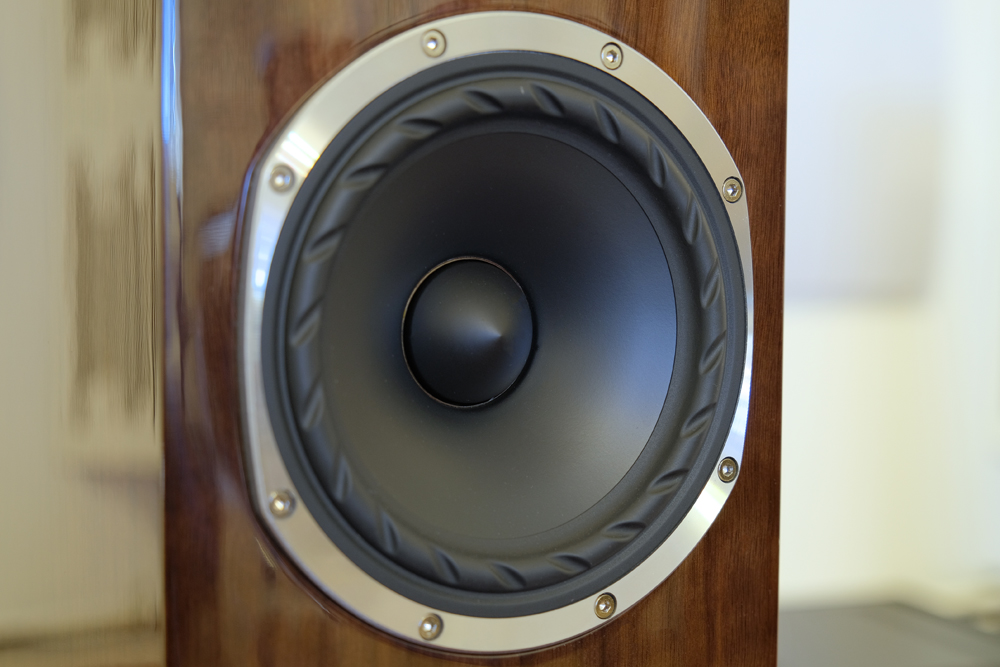
The same conductor’s handling of Rimsky-Korsakov’s Scheherazade (“The Sea and Sinbad’s Ship in E Major”) via the London Philharmonic Orchestra is spacious in terms of soundstage and precise with instrumental localisation. The blending of tweeter and mid-bas driver within the Isoflare design provides a coherent wholeness to the sonic picture. The piece then builds to a smashing crescendo followed by a delicately-interpreted movement completion. Genius.
The super-tight snare drum, cool guitar runs and bouncing bass of Jack Pantazis Quartet’s “Uncle-Confusion” from the jazz ensemble’s What? album had me toe-tappin’, scattin’ and boppin’. There was enjoyable tightness and snap to the snare, something that, once again, maintained superb rhythmic flow. That was fun.
Conclusion
Despite the Fyne Audio F501SP different sonic performance when compared to my much-missed double-the-size enclosure and driver Cheviot, there was an element of nostalgia attached to this review. Seeing that metal guide deep within the throat of the main driver conjured-up the many hours of delightful music I experienced all those years ago.
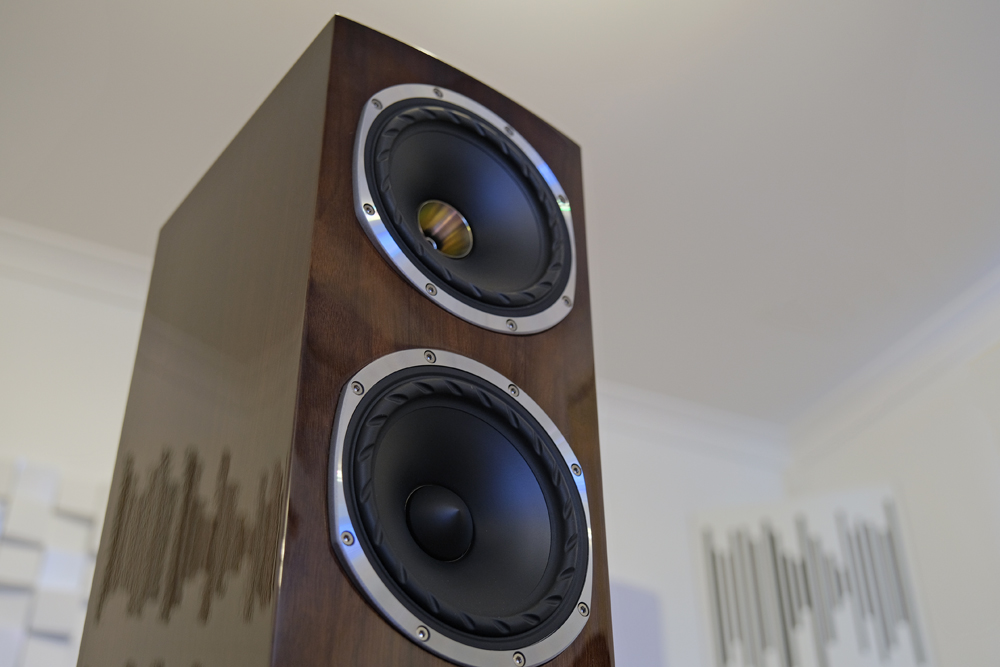
Yet, there were traits these diametrically- and chronologically-opposed speakers did share. The coherence, the dynamic expression and a difficult-to-articulate musical beauty which permeates every tune. In a modern way, the F501SP takes it further by offering a far more revealing presentation richer in micro-transients and detail while providing easy-placement resulting in superb low frequency performance. This no doubt comes from the implementation of 21st century materials and refined computer-modelled engineering. Plus, there’s that beautiful aesthetic to suit its time.
And to answer the question asked at the end of the introduction… it’s done just Fyne.
… Edgar Kramer
This email address is being protected from spambots. You need JavaScript enabled to view it.
Associated Equipment
- Speakers — Wilson Audio Alexia Series 2, Axis Loudspeakers VoiceBox S (nearfield monitor), Vermouth Audio Little Luccas Mk.II
- Amplifier — Gryphon Audio Antileon EVO
- Preamplifier — Supratek Cortese, Lightspeed Attenuator LDR passive, Totaldac d1-direct
- Sources — Digital: 432EVO High-End Music Server Roon Core, Yamaha CD-S2100 transport, Totaldac d1-direct DAC. Analogue: Transrotor Crescendo with Konstant Studio controller, Reed 1X Tonearm with upgraded internal wiring, Shelter Harmony cartridge, The Funk Firm Houdini cartridge decoupler, Supratek Cortese & REDGUM Audio RGPH2 phono stages
- Processor — DEQX PreMate
- Cables —PSC Audio custom design XLR, Vermouth Audio Reference loom,Vermouth Audio Black Pearl Mk.II loom
- Audio Rack — SGR Audio Statement Model V
- Acoustic Treatment — Vicoustic Multifuser Wood, Wavewood Ultra, Cinema Round Premium and Super Bass Extreme
- Miscellaneous — GigaWatt PF-1 EVO, Les Davis Audio Viscoelastic CLD discs, VRC Vinyl Record Cleaning systemplus miscellaneous accessories
Fyne Audio F501SP Loudspeakers
Price: AU$6995 (Standard Finish), AU$7995 (Premium Finish)
Warranty: Seven Years
Australian Distributor: HiFi Collective
+61 3 9013 4334
www.hificollective.com.au
Fyne Audio Limited
Suite 42, Grovewood Business Centre
Strathclyde Business Park
Bellshill, Lanarkshire
ML4 3NQ
United Kingdom
+44 (0) 141 428 4008
www.fyneaudio.com







